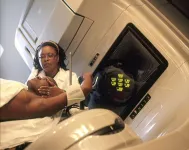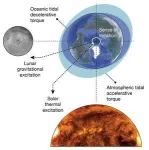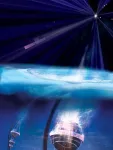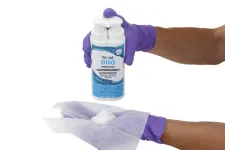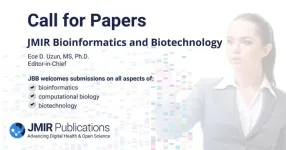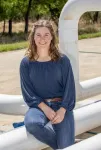(Press-News.org) A new material, created at the little-explored intersection of organic and inorganic chemistry, could not only enable more powerful solar panels, but it could also usher in the next generation of cancer treatments.
Described in a Nature Chemistry journal paper published today, the composite is made of ultra-tiny silicon nanoparticles, and an organic element closely related to those used in OLED televisions. It is capable of increasing the speed with which two molecules can exchange energy, and of converting lower-energy light into higher-energy light.
Only a handful of laboratories in the world are capable of making the silicon nanoparticles with the right specifications. One of those laboratories is led by Lorenzo Mangolini, a mechanical engineering and materials science professor at UC Riverside who helped invent the process for producing them.
“The new material improves on previous attempts we’ve made to create something that efficiently exchanges energy between two dissimilar components,” Mangolini said. “There are great opportunities to use this for a wide variety of applications, but perhaps one of the most important, from a human health perspective, is for cancer.”
High-energy light, such as ultraviolet laser light, can form free radicals able to attack cancer tissue. UV light, however, doesn’t travel far enough into tissues to generate therapeutic radicals close to the tumor site. On the other hand, near-infrared light penetrates deeply into the body, but doesn’t have enough energy to generate the radicals.
With the new material, the research team has demonstrated it is possible to achieve the emission of light with higher energy than the one aimed at the material, known as photon up-conversion. In addition to being efficient, the silicon “dots” that form the base of this high-energy material are not toxic.
Taking low-energy light and transforming it into a higher energy form could be used to boost the efficiency of solar cells by allowing them to capture near-infrared light that would normally pass through them. When optimized, the low-energy light could reduce the size of solar panels by 30%.
“These cells usually don’t use low-energy photons, but using this system, you could. We could make the arrays much more efficient,” Mangolini said.
There are a variety of applications involving infrared light that could be improved with the new silicon dot-based material. They include bioimaging, light-based 3D printing, and light sensors that would help self-driving cars through foggy weather.
This research was funded by the National Science Foundation and was performed by a team based at the University of Texas, Austin, University of Colorado, Boulder, and the University of Utah, as well as UCR. Not only is the research team excited about the potential applications, but about being able to design a new class of composite materials like this one.
Composites are materials that behave differently than their base components do when acting alone. As an example, composites of carbon fibers and resins are strong and lightweight and are used in airplane wings and many sporting goods.
“We now know how to take two extremely different substances and bond them strongly enough to create not just a mixture, but an entirely new material with distinct properties,” said Sean Roberts, University of Texas at Austin chemistry professor and corresponding paper author. “This is one of the first times this has been achieved.”
END
Previously unknown material could revolutionize cancer treatment
Tiny “dots” transform light, enabling big advancements
2023-06-12
ELSE PRESS RELEASES FROM THIS DATE:
19-hour days for a billion years of Earth’s history: Study
2023-06-12
It's tough accomplishing everything we want to get done in a day. But it would have been even more difficult had we lived earlier in Earth's history.
Although we take the 24-hour day for granted, in Earth's deep past, days were even shorter.
Day length was shorter because the Moon was closer. "Over time, the Moon has stolen Earth's rotational energy to boost it into a higher orbit farther from Earth," said Ross Mitchell, geophysicist at the Institute of Geology and Geophysics of the Chinese Academy of Sciences and lead author of a new study published in Nature Geoscience.
"Most models of Earth's rotation predict that day length was consistently shorter ...
New method enables study of nano-sized particles
2023-06-12
Researchers at Karolinska Institutet have created a new method of studying the smallest bioparticles in the body. The study, which is published in Nature Biotechnology, has considerable scientific potential, such as in the development of more effective vaccines.
Circulating around the body are nanoparticles that affect it in one way or another. For example, there are lipoproteins that maintain cell metabolism, pathogenic viruses that cause many diseases and lipid nanoparticles that are used to carry drugs, like recent lipid nanoparticle-based mRNA vaccines.
However, ...
Unveiling quantum gravity: New results from IceCube and Fermi data
2023-06-12
In a study published in Nature Astronomy today, a team of researchers from the University of Naples “Federico II”, the University of Wroclaw, and the University of Bergen examined a quantum-gravity model of particle propagation in which the speed of ultrarelativistic particles decreases with rising energy. This effect is expected to be extremely small, proportional to the ratio between particle energy and the Planck scale, but when observing very distant astrophysical sources, it can accumulate to observable levels. The ...
State agencies grant nationwide access to ultrasound disinfectant from Parker Labs
2023-06-12
FAIRFIELD, NJ—Parker Laboratories Inc. has announced that the environmental protection and pesticide control agencies of all 50 states have authorized registration of Tristel DUO, an intermediate-level disinfecting foam for the cleaning and disinfection of general medical surfaces—including noninvasive ultrasound transducers and their related equipment.
Tristel DUO is manufactured and distributed for US markets by Parker Laboratories under an exclusive commercial partnership with UK-based infection prevention company Tristel plc. Parker Laboratories ...
Researchers: win up to $40K studying effects of lipoprotein(a) on cardiovascular disease, stroke risk
2023-06-12
DALLAS, June 12, 2023 — The American Heart Association, the world’s leading voluntary organization focused on heart and brain health, invites scientific researchers across the globe to compete in a new data challenge to better inform the scientific understanding of how lipoprotein(a) [Lp(a)] levels impact the risk of cardiovascular disease and stroke. The winning project is eligible to receive a $40,000 USD cash prize.
High levels of Lp(a) — a low-density lipoprotein variant containing a protein called apolipoprotein(a) ...
Revolutionizing cardiology: AI-based technology offers accurate analysis of cardiac disease
2023-06-12
(Toronto, June 12, 2023) – New research published in JMIR Cardio reveals the remarkable potential of artificial intelligence (AI) technology in analyzing coronary angiography, a common diagnostic procedure for coronary artery disease. Led by Dr In Tae Moon, the study conducted at Uijeongbu Eulji University Hospital in Korea showcases the power of AI-based quantitative coronary angiography (AI-QCA) in enhancing clinical decision-making.
The study compared AI-QCA to intravascular ultrasound (IVUS), to validate its performance. IVUS is ...
Call for papers: JMIR Bioinformatics and Biotechnology
2023-06-12
JMIR Bioinformatics and Biotechnology (JBB) is a leading, international, peer-reviewed journal that aims to publish high-quality original research articles, reviews, and perspectives on all aspects of bioinformatics, computational biology, and biotechnology.
We invite researchers, educators, and practitioners to submit their original research articles, reviews, and perspectives to JBB. Our scope includes but is not limited to:
Bioinformatics, including genomic variation detection algorithms, tools, and databases
Artificial ...
SwRI’s Dr. Natalie Smith receives ASME Dedicated Service Award
2023-06-12
“It is an honor,” Smith said. “The ASME Turbo Expo community has been a valuable part of my professional development and it has been a pleasure to give back." Since joining SwRI in 2016, Smith has performed aerodynamic design and testing of turbomachinery and advanced system analysis for programs related to power generation, aviation, oil and gas, and energy storage, including next-generation supercritical carbon dioxide power cycles.
Smith has also managed three long-duration energy storage projects, developing a pumped thermal energy storage (PTES) demonstration facility, conducting a techno-economic feasibility study of ...
Press registration open for hybrid ACS Fall 2023 meeting
2023-06-12
Journalists who register for the fall meeting of the American Chemical Society (ACS) will have access to about 12,000 presentations on topics including agriculture and food, energy and fuels, health and medicine, sustainability and more. ACS Fall 2023 is a hybrid meeting being held virtually and in-person in San Francisco on Aug. 13-17 with the theme “Harnessing the Power of Data.”
ACS considers requests for press credentials and complimentary registration to meetings from reporters (staff and freelance) and public information officers at government, nonprofit and ...
Loneliness, insomnia linked to work with AI systems
2023-06-12
Employees who frequently interact with artificial intelligence systems are more likely to experience loneliness that can lead to insomnia and increased after-work drinking, according to research published by the American Psychological Association.
Researchers conducted four experiments in the U.S., Taiwan, Indonesia and Malaysia. Findings were consistent across cultures. The research was published online in the Journal of Applied Psychology.
In a prior career, lead researcher Pok Man Tang, PhD, worked in an ...
LAST 30 PRESS RELEASES:
Bis-pseudoindoxyls: a new class of single benzene-based fluorophores for bioimaging applications
Blocking a cancer-related pathway helps reduce spine deformities due to genetic disorder, finds new study
New study explores therapeutic potential of CRISPRCas3 genome-editing system
Korea University researchers revive an abandoned depression drug target using structurally novel NK1 receptor inhibitors
Jeonbuk National University researchers highlight advancements in chemical looping fluidized bed reactors
Tyrannosaurus rex grew up slowly: New study reveals the “king of dinosaurs” kept growing until age 40
Commercial water dispenser machines may contain more contamination than tap water
Death and doctors: New WSU study looks at medical student education on end-of-life care
The best hydrogen for heavy-duty transport is locally produced and green
Pregnancy-related high blood pressure varied among Asian, Pacific Islander subgroups
Measuring movement creates new way to map indoor air pollution
Europe’s crop droughts to get worse even as rain increases
New study identifies signature in blood to better predict type 2 diabetes risk
Research spotlight: developing “smart” nanoparticles to deliver targeted gene therapy in osteoarthritis
A CRISPR fingerprint of pathogenic C. auris fungi
Time warp: How marketers express time can affect what consumers buy
CBD treatment reverses key effects of fetal alcohol spectrum disorder in a mouse model
Blood sugar spikes linked to higher risk of Alzheimer's disease
Staying single for longer affects young people’s well-being
New method allows scientists to 3D-print structures within cells
Screening tool helps identify brain-related comorbidities in individuals with Duchenne muscular dystrophy
How do the active ingredients of monkfruit affect health?
News language and social networks: how do they affect the spread of immigration attitudes?
Researchers discover trigger of tendon disease
Your pet's flea treatment could be destroying the planet
Diabetes risk not associated with timing or type of menopause
Bulk inorganic crystals grown from water emit “handed” light
A new AI-based attack framework advances multi-agent reinforcement learning by amplifying vulnerability and bypassing defenses
While exploring the cosmos, astronauts also fuel explorations of the biology of aging and cellular resilience
Design and synthesis of Zr-IR825 nanoparticles for photothermal therapy of tumor cells
[Press-News.org] Previously unknown material could revolutionize cancer treatmentTiny “dots” transform light, enabling big advancements
